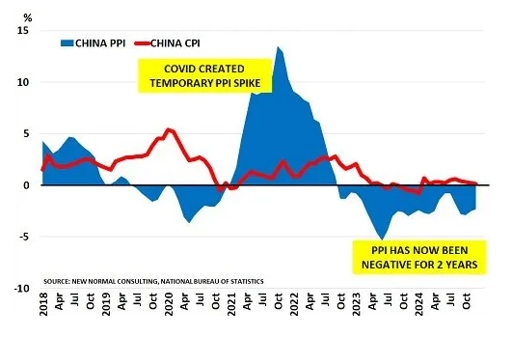- Housing was more than 1/3 of China’s GDP at its peak in 2015; today it is just 20%. This is having a major impact on local government finances, as land sales are their major source of revenue.
Caixin, China’s main business paper, summed up the crisis:
“Chinese local governments are desperately seeking new revenue streams by leveraging government-owned assets to address mounting debt pressures and dwindling coffers. A document from Bishan District in Chongqing, southwest China, went viral online, outlining the formation of a “Sell Everything to Save the Day” task force aimed at monetizing state-owned assets."
[…]
China’s property bubble was based on borrowed money, mainly financed through its ‘shadow banking’ system. Essentially, it was ‘subprime on steroids’:
- House price/earnings ratios reached an eye-popping 50x in Tier 1 cities like Shanghai.
- By comparison, in the US, New York prices were ‘only’ 14x when the US subprime bubble burst in 2008.
[…]
The reason is that the state owned all land in China till 1998. So people have never been through the normal peaks and troughs of a property cycle.
Instead, as they began buying property for the first time, they assumed the government would never let prices fall. But today, this wishful thinking has been exposed.
Now, the shadow banking system is disappearing. And as the chart shows, local government debt is rising rapidly. Essentially, China risks falling into a debt trap, where new loans have to be taken out to service old loans.
Even worse […] total debt is now >350% of GDP. The issue, as Prof Michael Pettis of Peking University noted in the summer, is that China’s stimulus programme has financed vast amounts of “non-productive investment.“
AND ITS POPULATION IS NOT ONLY AGEING, BUT FALLING
[…]
It is highly unlikely that [China’s current debt] could have been repaid even if the population was young and growing quickly. But China is at the other end of the spectrum, as the chart shows. Its population is now falling, and birth rates are half what they were before 1980.
The rise in China’s median age is therefore accelerating. This is now 40 years, double the level in 1980 before the One Child Policy was introduced.
[…]
China is now inevitably going to get old before it gets rich. Its export-oriented economy is facing the prospect of major trade barriers, as the US and Europe look to preserve jobs for their own populations.
And so China’s overcapacity problem is getting worse rather than better, even in areas where it has global market leadership:
- [China’s] solar industry has 80% of global demand, but is operating at just 45% of capacity.
- Its auto industry is operating at <50% of capacity. NIO’s boss says it is entering “the most fierce and brutal phase of competition.
[…]


